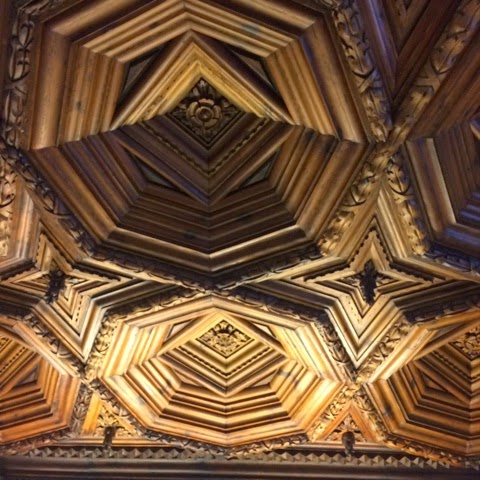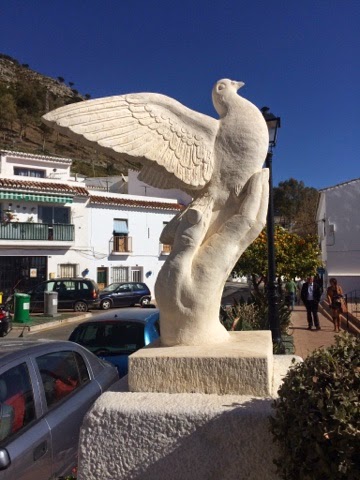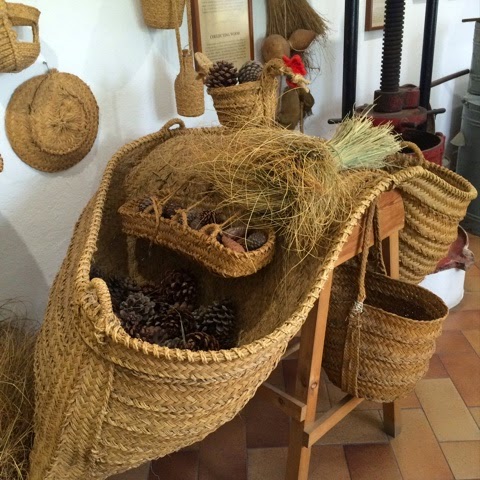We've been to Malaga twice more since my last post and I thought I'd share a host of pictures. I'll keep the commentary short.
Even seating can be art. This is an installation in a small park just across the street from where our bus deposits us in Malaga.
On our first of these two visits we stopped at another art museum. This one had both temporary art and pieces from West Africa including Ghana. This was in interesting juxtaposition. The large round object is not translucent, but more like semi-polished metal, while the central figures are not in it, but about 3 meters away.
These two figures in fact.
There were quite a few examples of these African pieces, which are mostly ceremonial or images of priests and fetishes.
This is a wonderful work of practical whimsy, a functioning jug.
A motley crew.
The building with the art was once the palace of the Bishop of Malaga and quite opulent. The visit was free, too. One area had these tiled murals. A couple of examples.
Note the musician on the right is playing a gaita, an Iberian (Spanish) bagpipe.
This domed ceiling was above a stairwell.
And this coffered ceiling was in above a hallway.
Remember we stopped at the Picasso Museum? I didn't show you any pictures, but did sneak a couple. This is a drawing, and more what you might think of when Picasso comes to mind.
But this is Picasso too - one of his early works.
Back on the streets of Malaga, we see details like this.
Tiled panels outside a lovely bodega.
And a Still Life with Oranges. Fresh orange juice is ubiquitous and in some of the juicing machines an apparatus like this feeds the oranges into the pressing mechanism.
You may remember the Art piece with a rabbit in exercise gear holding up a bench. We hadn't looked up. This installation is directly above it and we found it on this visit. The rabbit is here too.
More tiling - with rather effete men representing working Malagueñans. Trust me, the working men of Spain were and are not this thin or this tall.
We walked past the back side of the cathedral on our way to our next stop.
Which we did not get to by horse and carriage.
Our last visit to Malaga was to see the Alcazaba built in the 11th century by the Arab rulers of the time. It's considered the finest example of Arab fortification still remaining in Spain. Here's a link to a Wikipedia article. http://en.m.wikipedia.org/wiki/Alcazaba_of_M%C3%A1laga
To get to the Fort we got to walk through a long tunnel into the hill so we could ascend by elevator. And this time we were able to convince the ticket seller that we were both retired gentleman, so we paid €0.60 each to visit the area. Normal price for an adult is €2.20. The Spanish respect their elders.
This costume was on display at the beginning of the tunnel entrance. I don't think the Arabs were this tall though.
As usual, the buildings in the Arab world are decorated with many geometric pieces like this window. Because their religion does not allow representations of faces, their artists poured their talent into these beautiful traceries.
Of course the richly decorated Arab arches are everywhere.
And delicately detailed columns.
Even mosaic floors in entrance ways.
From above one gets marvellous views. The harbour here with a ferry in the right centre.
And a cityscape with the single tower of the cathedral you saw earlier.
I find the architectural volumes of the buildings so beautiful. This narrow alley is actually high in the Fort leading from one defensive position to another.
Through this beautiful arch way, you see a small channel. It's a water course, and water was actually running through it. The Arabs of the time were most adept at getting water to where it was needed.
Just below the Alcazaba is another historic sight from a much earlier era, a Roman theatre.
Note the walls of the Alcazaba directly above.
It was a busy morning of sight seeing. We found a church dedicated to Santiago Apostol, the patron saint of Spain, and of course the inspiration for the Camino de Santiago which we have shared before.
Another Piéta in the church. This polychrome carving is quite well done. For those who care to expand their knowledge, a link to the technique of polychrome for you. http://en.m.wikipedia.org/wiki/Polychrome
This is the Santiago cross which is seen wherever Santiago appears. These were glass panels lying on a wooden platform.
High above the Altar, Santiago reigns, with his staff carrying his water gourd for the pilgrimage. He is very often depicted in this way, although he is missing his robe and his hat with scallop shell.
Another richly decorated ceiling in the church.
Outside a shop sells local Malagueña products including salt fish, cured sausages, olive oil and the local sweet wine, called Malaga Virgen. It's used to make a delicious dish with salt fish, in a sauce with raisins and onions. We had it several times at our local bar down the street for the Menú del dia.
Bacalao Malagueña (at La Aldea on our street in Torremolinos).
In the last several days we've been smelling a beautiful aroma as we walk in the streets. I thought it was jasmine, but today on my walk I discovered the scent is coming from these flowers, which are orange blossoms. It's heavenly.
And I leave you with a bit of whimsy. I'm not sure if my coffee server this morning was attempting to be arty or whether this was an accidental representation of a very pregnant Minnie Mouse, but I appreciated it anyway.
One final image - this one here in Torremlinos. On a street between buildings just off the Paseo Marítimo, this vine grows across, and into the building next door.
This morning we are leaving Torremolinos. We have had two months, enjoying sightseeing, living in another country, eating and drinking perhaps a little too well. Now we are off exploring with stops laid out for the next month. Expect pictures from our stops in the towns and cities along the way to Barcelona and our flight home on April 29.




































































































